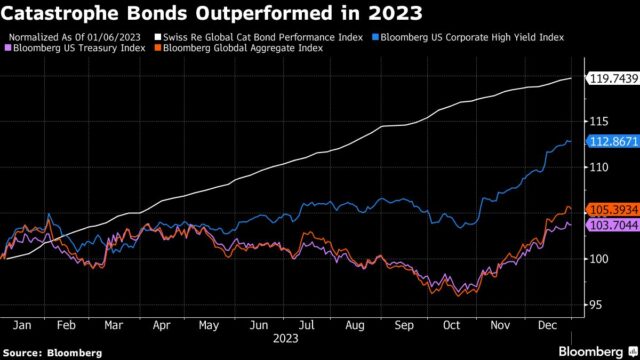(Bloomberg) — As hedge funds rake in record profits in one of the riskiest corners of the debt market, the products behind those returns are now drawing in more mainstream investors.
Most Read from Bloomberg
Catastrophe bonds, which last year formed the basis for the best-performing hedge fund strategy, have been delivering gains that trounce those of other high-risk fixed-income products. In 2023, the securities soared 20%, compared with 13% for high-yield US corporate bonds. US Treasuries rose roughly 4%.
Niklaus Hilti, head of insurance-linked strategies at the investment arm of Credit Suisse, which is now part of UBS Group AG, says those eye-popping returns are feeding appetite for so-called cat bonds in circles beyond the domain of hedge funds.
“The interest has recently increased amongst institutional investors,” Hilti said. “Even if we believe that these returns won’t be reproduced in 2024, we think that small allocations to the asset class can make sense for investors in order to diversify investment portfolios.”
Catastrophe bonds are used by the insurance industry to shield itself from losses too big to cover. That risk is instead transferred to investors willing to accept the chance that they may lose part or even all of their capital if disaster hits. In exchange, they can garner outsize profits if a contractually pre-defined catastrophe doesn’t occur.
Read More: How Global Warming Makes Extreme Weather More Likely: QuickTake
The cat bond market has existed for decades but has recently had a resurgence due to weather events fueled by climate change. Combined with decades-high inflation, which has added to the cost of rebuilding after natural disasters, cat bonds have attracted record levels of issuer and investor activity.
At the same time, some cat bonds have been written with tighter trigger clauses, an outcome that favors investors and cat bond funds because it reduces the likelihood of a payout.
Hedge funds that enjoyed bumper returns on cat bonds and other insurance-linked securities last year include Fermat Capital Management, Tenax Capital and Tangency Capital.
Read More: Hedge Funds Rake in Huge Profits Betting on Catastrophe Risk
While niche hedge fund investors continue to dominate the market for cat bonds, more mainstream institutional investors are building up their presence, according to data compiled by Bloomberg. These include Schroders Plc, GAM Holding AG and Credit Agricole SA. That’s coincided with growth in the supply of such securities, with insurers increasing issuance by 50% last year.
Daniel Ineichen, Schroders’ head of portfolio management overseeing about $5 billion of insurance-linked securities, says high returns as well as the appeal of cat bonds as a portfolio diversifier have driven business for the asset manager. He notes that a quarter of the investors seeking exposure to cat bonds at Schroders over the past six months are new to the firm’s catastrophe bond team.
A lot of the new interest is coming from institutional investors and wealth-management platforms, Ineichen said.
A Schroders cat bond fund targeting US investors that was launched in the middle of last year has already attracted $100 million, he said. “We have clearly seen that the flavor of the year was cat bonds” and “we see very attractive return patterns for 2024.”
Swiss Re, which has long been involved in the proprietary trading of cat bonds, has been broadening its strategy. In July 2022, it set up an investment manager called Swiss Re Insurance-Linked Investment Advisors Corp., which oversees third-party capital and currently has about $1.5 billion of assets under management.
Given the current market trajectory, those assets may exceed $2 billion by 2025, said MariaGiovanna Guatteri, the group’s chief investment officer. Returns have been in the double digits and that’s attracting interest from a growing roster of non-ILS specialist investors, she said.
To be sure, investors moving into cat bonds are taking on highly complex and highly risky instruments that don’t move in tandem with the rest of the market. And when payment clauses are activated, losses can be considerable.
Globally, the market for insurance-linked securities reached about $100 billion at the end of the third quarter of 2023, insurance broker Aon Plc estimates. Cat bond issuance alone hit an all-time high of more than $16 billion in 2023, including non-property and private transactions, bringing the total market for the securities to $45 billion, according to Artemis, which tracks the ILS market.
“The risk premium has widened significantly over the last two years and, most importantly, structures have been de-risking, so the market is in a more favorable state than in the recent past,” Hilti said.
Last year, everything came together for cat-bond investors. Brett Houghton, a managing director at Fermat, which looks after about $10.8 billion of assets, describes 2023 as a “unicorn year,” with “strong investor interest and the need for the insurance market to issue more and more.”
The recent gains in cat bonds were buoyed by the fact that the hurricane season was milder than in 2022, meaning bondholders had to cover fewer losses. While the consensus view is it will be hard to achieve a repeat of those uniquely supportive circumstances, Houghton said investors are still seeing “attractive returns.”
Hilti said the gains of 2023 don’t need to be repeated this year for the securities to remain an attractive investment.
“We expect the market to relax from the widest spreads but to remain on very healthy levels,” he said. “The higher interest rates, which might stay higher for longer, also help to deliver positive returns.”
Cat bonds will always remain “a niche investment,” Hilti said. But those investors willing to take on the risks are trying to get a foothold after the “stronger momentum and higher risk premia” they’d been waiting for has now arrived, he said.
Most Read from Bloomberg Businessweek
©2024 Bloomberg L.P.




